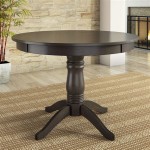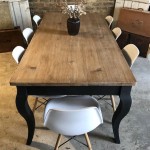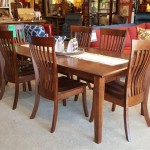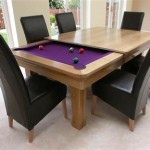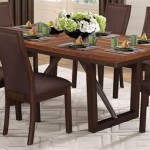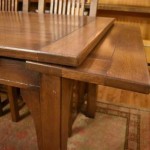Best Materials for a Dining Table: A Comprehensive Guide
The dining table serves as a central gathering point in many homes, hosting meals, conversations, and memories. Selecting the right dining table involves careful consideration, with the material being a primary factor. The chosen material influences not only the table's aesthetic appeal but also its durability, maintenance requirements, and overall suitability for the intended use and lifestyle.
This article provides a comprehensive overview of various materials commonly used in dining table construction, highlighting their characteristics, advantages, and disadvantages to aid in making an informed decision. The focus is on providing objective information, enabling readers to evaluate the best material for their specific needs and preferences.
Solid Wood: Timeless Elegance and Durability
Solid wood dining tables are renowned for their timeless appeal, durability, and inherent natural beauty. The term "solid wood" refers to tables constructed from planks of hardwood sourced from trees such as oak, maple, walnut, cherry, and mahogany. Each wood species offers a unique grain pattern, color variation, and hardness level, contributing to the distinctive character of the finished table.
Oak is a popular choice for dining tables due to its exceptional strength and resistance to wear and tear. Its prominent grain pattern adds visual interest, and it stains well, allowing for a wide range of finishes. Maple is another durable hardwood, characterized by its smooth, fine grain and light color. It is often preferred for contemporary and minimalist designs. Walnut offers a rich, dark color and a distinctive grain pattern, making it a sought-after choice for creating elegant and sophisticated dining spaces. Cherry wood is prized for its warm reddish-brown hue and its ability to develop a richer patina over time. Mahogany is a classic hardwood known for its durability, stability, and attractive reddish-brown color, often used in traditional and formal dining settings.
Solid wood tables offer several advantages. Their inherent strength and durability ensure they can withstand daily use and resist dents, scratches, and warping. Solid wood can be easily refinished or repaired, extending the table's lifespan considerably. The natural beauty and warmth of wood create a welcoming and inviting atmosphere in the dining area. Moreover, solid wood tables can be passed down through generations, becoming treasured family heirlooms. However, solid wood tables also have some drawbacks. They are typically more expensive than tables made from other materials. Solid wood is susceptible to changes in humidity and temperature, which can lead to expansion and contraction, potentially causing cracks or warping if not properly maintained. Regular cleaning and oiling are necessary to preserve the wood's natural beauty and prevent damage.
When selecting a solid wood dining table, it is essential to consider the type of wood, the construction quality, and the finish. Look for tables made from kiln-dried wood, which has been properly dried to minimize the risk of warping or cracking. A well-constructed table will have sturdy legs and a solid frame, ensuring stability and longevity. The finish should be durable and resistant to scratches and stains. Consider the overall style and design of the table to ensure it complements the existing décor of the dining room.
Wood Veneer: Affordability and Versatility
Wood veneer dining tables offer an alternative to solid wood, providing a similar aesthetic appeal at a more affordable price point. Wood veneer consists of thin layers of real wood that are bonded to a core material, typically particleboard, MDF (medium-density fiberboard), or plywood. This construction method allows manufacturers to utilize more expensive wood species, such as walnut or cherry, without the high cost associated with solid wood.
The primary advantage of wood veneer tables is their affordability. They are significantly less expensive than solid wood tables, making them an attractive option for budget-conscious consumers. Wood veneer also offers greater design versatility. The thin veneer layers can be applied to various core materials, allowing for curved or shaped designs that are difficult or impossible to achieve with solid wood. Veneer tables are also less prone to warping or cracking than solid wood because the core material provides stability and resistance to changes in humidity and temperature.
However, wood veneer tables also have some limitations. The veneer layer is relatively thin, making it susceptible to scratches and damage. If the veneer is chipped or peeling, it can be difficult to repair. While veneer tables are less prone to warping than solid wood, they are still susceptible to water damage. Spills should be cleaned up promptly to prevent the veneer from lifting or bubbling. The durability of a veneer table depends on the quality of the veneer, the core material, and the adhesive used to bond them together. A poorly constructed veneer table may not last as long as a solid wood table.
When selecting a wood veneer dining table, it is crucial to consider the quality of the veneer, the core material, and the finish. Look for tables with a thick veneer layer that is securely bonded to the core. MDF is generally considered a better core material than particleboard because it is denser and more resistant to moisture. The finish should be durable and resistant to scratches and stains. In addition, assess the edge banding, which covers the exposed edges of the core material. High-quality edge banding will be seamless and well-attached, preventing moisture from seeping in and damaging the core.
Glass: Modern Sophistication and Easy Maintenance
Glass dining tables offer a sleek and modern aesthetic, adding a touch of sophistication to any dining space. Glass tables are typically made from tempered glass, which is a type of safety glass that is significantly stronger and more resistant to breakage than standard glass. If tempered glass does break, it shatters into small, blunt pieces, reducing the risk of injury.
One of the primary advantages of glass dining tables is their aesthetic appeal. The transparent surface allows light to pass through, creating a sense of spaciousness and openness in the dining room. Glass tables can complement a variety of décor styles, from contemporary to minimalist to transitional. Glass is also easy to clean and maintain. Spills and stains can be wiped away with a damp cloth, and glass is resistant to most household cleaners. The non-porous surface prevents bacteria and odors from being absorbed, making glass a hygienic choice for dining.
However, glass tables also have some drawbacks. They can be prone to scratches and fingerprints, requiring frequent cleaning to maintain their pristine appearance. The hardness of glass can also make it less comfortable to use for extended periods, as it lacks the warmth and tactile appeal of wood. While tempered glass is durable, it is still susceptible to breakage if subjected to excessive force or impact. Glass tables can also be perceived as cold or sterile, lacking the warmth and character of natural materials.
When selecting a glass dining table, it is crucial to consider the thickness of the glass, the type of base, and the overall design. Look for tables with tempered glass that is at least 0.5 inches (12 mm) thick for added durability and stability. The base should be sturdy and well-constructed, providing adequate support for the glass top. Common base materials include metal, wood, and acrylic. Consider the shape and style of the base to ensure it complements the glass top and the overall décor of the dining room. Opt for glass with a beveled edge to minimize the risk of chipping or cracking and add a touch of elegance.
Metal: Industrial Chic and Extreme Durability
Metal dining tables offer a durable and industrial-chic aesthetic. These tables are constructed from materials like steel, aluminum, or iron. Metal is prized for its strength and ability to withstand heavy use. Styles range from sleek, modern designs to more rustic, industrial looks incorporating exposed welds and rivets.
The primary advantage of metal dining tables is their durability. Metal is highly resistant to damage from scratches, dents, and heat. This makes metal a practical choice for households with children or pets, or for those who frequently entertain. Metal tables are often lighter than solid wood tables, allowing for easier movement. The smooth surfaces of metal tables are easy to clean, requiring only a damp cloth and mild soap. Metal is non-porous, offering resistance to stains and harboring bacteria. Metal tables are often available in a range of finishes, from polished and shiny to matte and textured, providing design versatility.
Despite their durability, metal tables have some drawbacks. Metal can feel cold to the touch, and many consider them less inviting than wood. Highly polished metal surfaces can show fingerprints. Metal can be susceptible to rust if the finish is damaged or if the table is exposed to moisture over time. Lower-quality metal tables can be lightweight and unstable. Some metal tables can have sharp edges, posing a safety hazard.
When choosing a metal dining table, consider the type of metal, the gauge or thickness of the metal, and the finish. Stainless steel offers the best combination of durability and resistance to rust. Aluminum is lightweight and resistant to corrosion but may not be as strong as steel. Cast iron is heavy and durable but susceptible to rust. A thicker gauge of metal indicates a more robust and durable table. Powder-coated finishes are resistant to scratches and rust. Check for smooth, rounded edges to prevent injuries. Consider the weight capacity of the table, especially if you plan to place heavy items on it.
Stone: Natural Beauty and Lasting Impression
Stone dining tables offer a combination of natural beauty and remarkable durability. These tables are typically crafted from materials such as marble, granite, or slate. Each type of stone has unique veining and color variations, ensuring that each table is one-of-a-kind.
The main advantage of stone dining tables is their aesthetic appeal. The natural patterns and colors of stone bring an organic element to the dining room. Stone is incredibly durable and can last for generations with proper care. Stone is heat resistant, making it suitable for placing hot dishes directly on the surface. Stone's weight provides exceptional stability, preventing the table from wobbling or tipping. Because stone is a natural material, it adds a sense of luxury and sophistication to any space. The coolness of stone can be beneficial in warmer climates.
Stone tables have several disadvantages. Stone is porous and can stain if spills are not cleaned promptly. Sealing the stone regularly is necessary to protect it from stains and moisture. Stone is extremely heavy, making it difficult to move. Stone tables are also more expensive than those made from other materials. Stone can be cold and hard, which may not appeal to everyone. Chips and cracks can occur if the table is subjected to significant impact, though professional repairs are usually possible.
Selecting a stone dining table involves considering the type of stone, the thickness of the stone, and the type of finish. Marble offers a luxurious look but requires more maintenance due to its porosity. Granite is more durable and stain-resistant than marble. Slate provides a rustic appearance and good stain resistance. Thicker slabs of stone are more durable and visually impressive. Polished finishes highlight the natural beauty of the stone but can be more prone to scratches. Honed or matte finishes are more resistant to scratches and provide a softer look. Be sure to choose a sealer specifically designed for natural stone and apply it regularly according to the manufacturer's instructions.

What Is The Best Material For Your Dining Table Top Zad Interiors

The One Stop Guide To Materials For Table Tops

The Ultimate Guide To Choosing Best Dining Table Material Cozylant

How To Choose The Best Tabletop Material For Your Formal Dining Room

5 Best Materials For Your Dining Table Urban Concepts

What Is The Best Material For A Dining Table Complete Guide

Types Of Table Tops A Er S Guide Grain Frame

What Makes The Best Dining Table Material Granite Or Marble

What Makes The Best Dining Table Material Granite Or Marble

Table Top Ing Guide Everything You Need To Know Rosehill Contract Furniture

